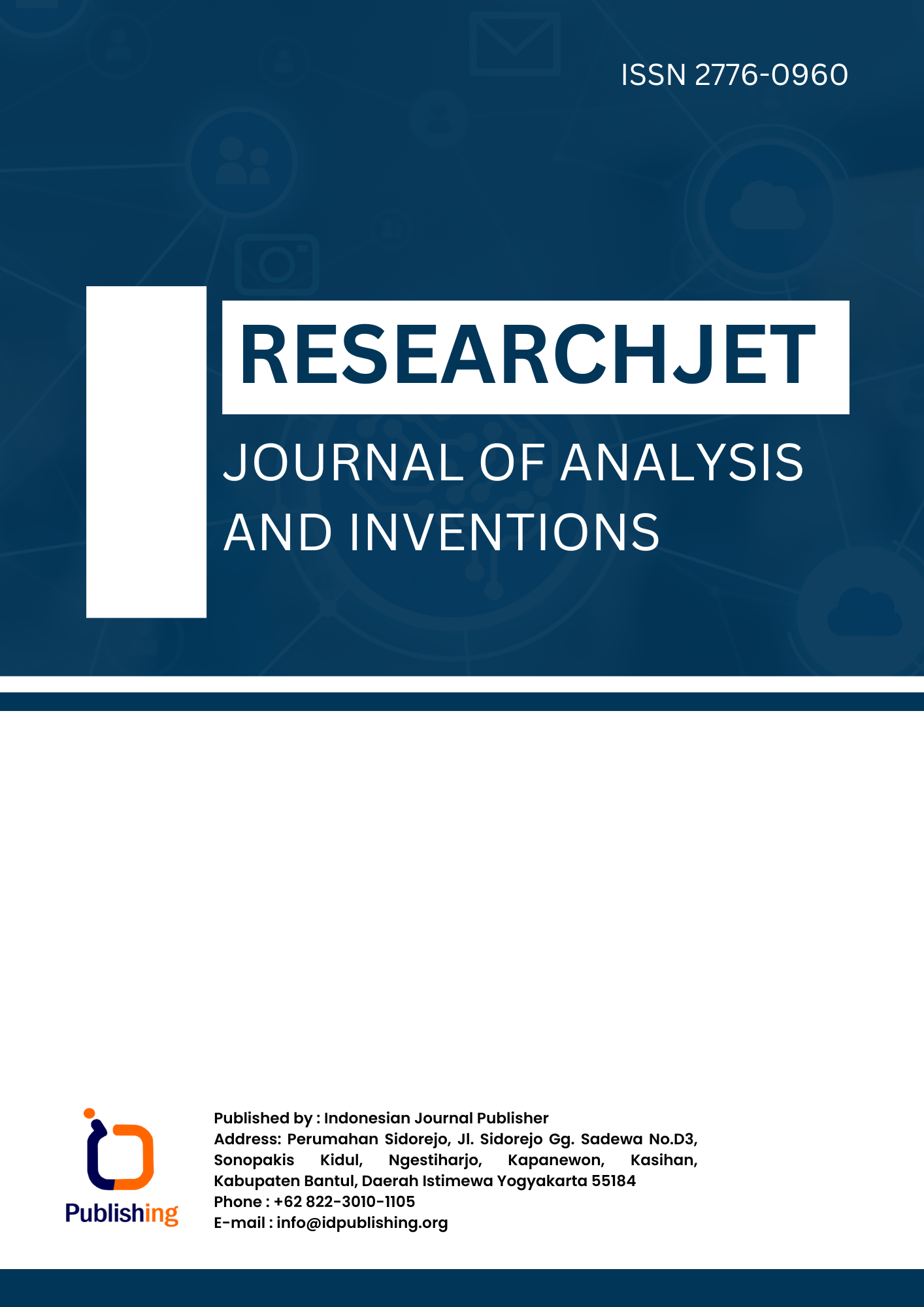Analisis Putusan Tindak Pidana Asusila Terhadap Anak di Kabupaten Sidoarjo (Studi Kasus pada Pengadilan Negeri Sidoarjo)
DOI:
https://doi.org/10.47134/researchjet.v3i1.14Keywords:
crime, immoral, childAbstract
Lately, immoral acts involving children often occur, One of them is the number of case reports regarding rape, harassment, and so on. The immoral act of rape is one of the forms of violence against children. The purpose of this study was to determine the analysis of decisions on immoral crimes against children in Sidoarjo Regency. The research method used is normative juridical with a statutory approach. The results of this study show that there is a disparity between the decisions of one another in the 2019-2021 timeframe, both from the judge's considerations, decisions and other things. The benefit of this research is that the author hopes that this writing can be useful by providing knowledge and information to the public as a reference to find out how to analyze the decision on immoral actions against children in Sidoarjo Regency (Case Study at the Sidoarjo District Court). The analysis of the legal material used is deductive reasoning, what is meant by deductive reasoning analysis here is reasoning based on a mindset that has a general nature to draw conclusions on a specific nature.
References
Abidin Farid, Z. (2007). Hukum Pidana 1. Sinar Grafika.
Aggarwal, S. (2006). A training tool for internet crimes against children cases. IFIP Advances in Information and Communication Technology, 222, 317–330. doi: 10.1007/978-0-387-36891-7-25 DOI: https://doi.org/10.1007/0-387-36891-4_25
Arsawati, I. N. J. (2021). A criminological outlook of cyber crimes in sexual violence against children in Indonesian Laws. International Journal of Criminology and Sociology, 10, 219–223. doi: 10.6000/1929-4409.2021.10.26 DOI: https://doi.org/10.6000/1929-4409.2021.10.26
Berry, M. (2012). Media coverage and public understanding of sentencing policy in relation to crimes against children. Criminology and Criminal Justice, 12(5), 567–591. doi: 10.1177/1748895811432956 DOI: https://doi.org/10.1177/1748895811432956
Brady, P. Q. (2017). Crimes against caring: Exploring the risk of secondary traumatic stress, burnout, and compassion satisfaction among child exploitation investigators. Journal of Police and Criminal Psychology, 32(4), 305–318. doi: 10.1007/s11896-016-9223-8 DOI: https://doi.org/10.1007/s11896-016-9223-8
Bross, D. (2000). Client evaluation of a consultation team on crimes against children. Child Abuse and Neglect, 24(1), 71–84. doi: 10.1016/S0145-2134(99)00123-4 DOI: https://doi.org/10.1016/S0145-2134(99)00123-4
Djamil, M. N. (2013). Anak Bukan untuk Dihukum. Sinar Grafika.
Fajar, M., & Achmad, Y. (2015). Dualisme Penelitian Hukum Normatif dan Empiris.
Gurevich, L. (2008). Patriarchy? Paternalism? Motherhood discourses in trials of crimes against children. Sociological Perspectives, 51(3), 515–539. doi: 10.1525/sop.2008.51.3.515 DOI: https://doi.org/10.1525/sop.2008.51.3.515
Haack, K. (2013). [Crimes against children and adolescent by the national socialism regime]. Zeitschrift Für Kinder- Und Jugendpsychiatrie Und Psychotherapie, 41, 12–19. doi: 10.1024/1422-4917/a000226 DOI: https://doi.org/10.1024/1422-4917/a000226
Hagan, F. E. (2013). Pengantar Kriminologi: Teori, Metode, dan Perilaku Kriminal.
Hoz, G. T. D. La. (2021). New Trends in Online Crime Using Social Networking Sites and Apps against Children and Adolescents: Police-Based Longitudinal Research. International Journal of Cyber Criminology, 15(1), 31–49. doi: 10.5281/zenodo.4766531
Kitab Undang-Undang Hukum Pidana (KUHP). (2003).
Kristianti, N. M. D. (2014). Kejahatan Kekerasan Seksual: Perkosaan Ditinjau dari Perspektif Kriminologi. 7(3). DOI: https://doi.org/10.24843/JMHU.2014.v03.i03.p02
Lang, R. (1991). Parent‐child relations in offenders who commit violent sexual crimes against children. Behavioral Sciences & the Law, 9(1), 61–71. doi: 10.1002/bsl.2370090108 DOI: https://doi.org/10.1002/bsl.2370090108
Leclerc, B. (2009). Offender-victim interaction and crime event outcomes: Modus operandi and victim effects on the risk of intrusive sexual offenses against children. Criminology, 47(2), 595–618. doi: 10.1111/j.1745-9125.2009.00151.x DOI: https://doi.org/10.1111/j.1745-9125.2009.00151.x
Moeljatno. (1993). Azas-azas Hukum Pidana. Bumi Aksara.
Poerwadarminta, W. J. S. (1976). Kamus Umum Bahasa Indonesia. Balai Pustaka.
Prodjodikoro, W. (2002). Tindak Pidana Tertentu di Indonesia. PT. Refika Aditama.
Prodjodikoro, W. (2014). Asas-Asas Hukum Pidana di Indonesia. Refika Aditama.
Sarwono. (2006). Psikologi Remaja. Raja Grafindo Persada.
Satija, S. (2015). Crime against women and children in Delhi: Analysis of secondary and empirical data. Economic and Political Weekly, 50(9), 87–97.
Sianturi, S. R. (2002). Azas-azas Hukum Pidana di Indonesia dan Penerapannya. Storia Grafika.
Soedibroto, R. S. (2004). KUHP dan KUHAP (Dilengkapi Yurisprudensi Mahkamah Agung dan Hoge Road). Raja Grafindo Persada.
Ulfa, M. (2012). Peran Kejaksaan dalam Penanggulangan Tindak Kesusilaan yang Dilakukan oleh Remaja di Lampung Tengah.
Wahid, A., & Irfan, M. (2011). Perlindungan terhadap Korban Kekerasan Seksual. Refika Aditama.
Zulaika, S., & Ginting, R. (2018). Tujuan Kriminologi Kekerasan Seksual Terhadap Anak di Wilayah Kota Tangerang Selatan. 7(3).
Downloads
Published
How to Cite
Issue
Section
License
Copyright (c) 2023 Dwi Anita Puspita Sari, Emy Rosnawati

This work is licensed under a Creative Commons Attribution 4.0 International License.








